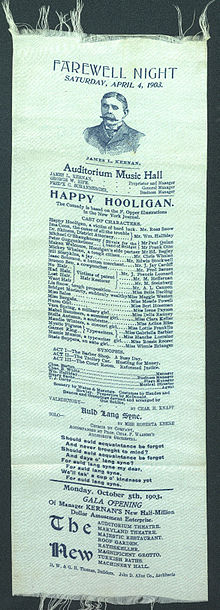Happy hooligan
Happy Hooligan is the best-known cartoon character by the American comic artist Frederick Burr Opper and the title character of the comic strip of the same name , which appeared from 1900 to 1932.
action
The focus is on the good-natured, Irish-born drifter Happy Hooligan , who carries a tin can (initially blue, later red) on his head as an identification mark. Other people are his brothers Gloomy Gus and Montmorency and his three alike-looking nephews. Happy tries to make a good impression on Suzanne, whom he admires, which he regularly fails.
publication
Happy Hooligan's first strip came out on March 26, 1900, after William Randolph had recruited Hearst Opper to draw for his newspapers. If the publication rhythm of the strip was irregular at the beginning, its establishment was accompanied by a more uniform appearance and the establishment of both a Sunday page and a daily strip . An eye disease failed Opper, who employed no assistants, to draw in the last five years of his life, so that the last strip appeared on August 14, 1932. Under the title The Happy Hannes , Happy Hooligan appeared in the Sunday supplements of the Morgen-Journal’s , a German-language edition of the New York Journal that was published by Hearst from 1890 to 1918. In Italy, Happy Hooligan's adventures were published under the title Fortunello in the children's supplement Corriere dei piccoli .
From Happy Hooligan appeared in the period from 1900 to 1922, numerous films, both as real and as a cartoon . Between 1900 and 1903 alone, James Stuart Blackton produced eleven short films with himself in the title role. In addition, Mort Walker and Jerry Dumas had the character of the Happy Hooligan regularly appear in their comic strip Sam's strip , which appeared in the early 1960s.
reception
Andreas C. Knigge compares Happy Hooligan with Charlie Chaplin's tramp , who has suffered a setback and turns to new adventures. According to Knigge, with Happy Hooligan , Opper was also the first draftsman to use vagabonds for funnies .
In the 1950s, Der Spiegel took the view that Soviet propaganda derived the term hooliganism from Happy Hooligan .
literature
- Franco Fossati: The large illustrated Ehapa comic lexicon . Ehapa Verlag, Stuttgart 1993, ISBN 3-7704-0865-9 , pp. 123-124, 191.
- Andreas C. Knigge: Comic Lexicon . Ullstein Verlag, Frankfurt am Main, Berlin and Vienna 1988, ISBN 3-548-36554-X , pp. 349-350.
- Andreas C. Knigge: Comics . Rowohlt Taschenbuch Verlag, Reinbek 1996, ISBN 3-499-16519-8 , pp. 24-25.
Web links
Individual evidence
- ↑ Andreas C. Knigge: ZEICHEN-WELTEN , accessed on December 5, 2012
- ^ Franco Fossati: The large illustrated Ehapa comic lexicon . Ehapa Verlag, Stuttgart 1993, ISBN 3-7704-0865-9 , p. 134.
- ^ Frederick Burr Opper in the Internet Movie Database , accessed on September 9, 2010
- ↑ Ellen Lindner: Happy Hooligan. In: Paul Gravett (ed.) And Andreas C. Knigge (transl.): 1001 comics that you should read before life is over . Edition Olms, Zurich 2012, p. 33.
- ^ Franco Fossati: The large illustrated Ehapa comic lexicon . Ehapa Verlag, Stuttgart 1993, ISBN 3-7704-0865-9 , p. 227.
- ^ Andreas C. Knigge: Comics . Rowohlt Taschenbuch Verlag, Reinbek 1996, ISBN 3-499-16519-8 , p. 25.
- ↑ The watchful women . In: Der Spiegel . No. 46 , 1954 ( online ).

